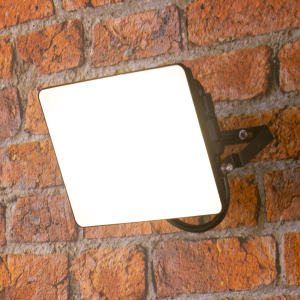Outdoor lighting has come a long way from the days of simple wall-mounted lamps. Today, homeowners are choosing smarter, more responsive options — and floodlights with motion detectors are a popular option. Combining security, convenience, and energy efficiency, these lights only activate when they’re truly needed. If you’re looking to brighten your home’s exterior while adding an extra layer of protection with security lights, this guide will walk you through everything you need to know.
What is a motion sensor floodlight?
A motion sensor floodlight is an outdoor light fixture equipped with a PIR (Passive Infrared) sensor that detects heat and movement. When someone walks within the sensor’s range — whether it’s a family member arriving home, a delivery driver at your door, or an unexpected visitor — the light switches on instantly. Unlike regular floodlights that stay on continuously, motion-activated models only illuminate when needed, saving energy while offering on-demand visibility.
Modern versions often include adjustable settings, such as sensitivity, light duration, and detection range, so you can tailor them to your environment and avoid false triggers from pets or passing traffic.
Benefits of using floodlights with motion detection
- Enhanced security – Motion-activated floodlights act as a strong deterrent for potential intruders. The sudden burst of light draws attention to movement and gives the impression that someone is home or watching.
- Convenience – These lights are ideal for when your hands are full or you’re returning home after dark. No need to fumble for a switch — the light comes on automatically as you approach.
- Energy efficiency – Because they only activate when motion is detected, motion detector lights consume less power than traditional floodlights left running all night. Many use LED bulbs, which further reduce electricity use.
- Safety – They help prevent slips or accidents by lighting up paths, driveways and steps at just the right moment — especially useful during winter evenings or rainy conditions.
Where to install motion detector floodlights
- Driveways and garages – Automatically light up the area as you park, walk in, or unload your car. This not only improves visibility for reversing or unloading, but also provides a safer, more welcoming entry when you arrive home after dark.
- Front entrances – Welcome guests with light and discourage loitering near your front door. It’s an easy way to make your home look occupied and feel more secure, especially during the evening hours.
- Side alleys and garden paths – Illuminate often-overlooked areas that can be vulnerable or hard to navigate. These narrow or shaded spaces are common blind spots and benefit greatly from lighting that activates when someone approaches.
- Back gardens and sheds – Protect tools, bikes, and outdoor furniture with lighting that alerts you to any unexpected activity. Whether it’s a curious fox or an uninvited guest, motion-activated lights with a wide detection angle help draw attention and deter unwanted presence.
What to look for when buying one
Before buying a motion detector floodlight, t’s important to understand the key features that will suit your home, lifestyle, and installation location. Here’s what to consider before making your purchase:
- Sensor range and angle – Most motion detectors can sense movement between 6 and 12 metres away, with coverage angles up to 180°. The right range depends on where you’re installing the light — a wide-angle sensor is great for open driveways, while a more focused sensor may be better suited for narrow paths or entrances to avoid unwanted triggers.
- Adjustable settings – Look for models that allow you to fine-tune detection sensitivity, how long the light stays on, and whether it only activates after dark. These features help minimise false triggers from pets, passing cars, or wind-blown branches, and ensure the light works in line with your daily routine.
- Brightness and colour temperature – For most domestic use, floodlights between 1000 and 2000 lumens provide sufficient illumination without being overpowering. Cool white light (4000K–5000K) is ideal for security as it offers crisp, clear visibility, whereas warm white light may suit more decorative or welcoming applications like patios or porches.
- Weather resistance – Outdoor lighting must be able to handle the elements, so check for an IP65 rating or higher to ensure protection from rain, dust, and cold. This is especially important in the UK’s variable climate, where moisture, wind, and frost can damage lesser-rated fittings over time.
- Power source – You can choose between hardwired, battery-operated, or solar-powered floodlights. Hardwired models are more permanent and ideal for high-traffic areas, while battery and solar options offer quick, cable-free installation — perfect for remote spots like sheds or rear gardens where wiring is less practical.
Final thoughts
Floodlights with motion detectors are a practical and effective solution for enhancing your home’s security, safety, and overall usability after dark with the help of sensor outdoor technology. With adjustable settings, smart sensor technology, and a range of designs to suit different spaces, they provide targeted lighting without wasting energy. Whether you’re lighting a driveway, side passage, or back garden, choosing the right motion-activated floodlight makes all the difference. It’s a simple upgrade that brings peace of mind — night after night.






